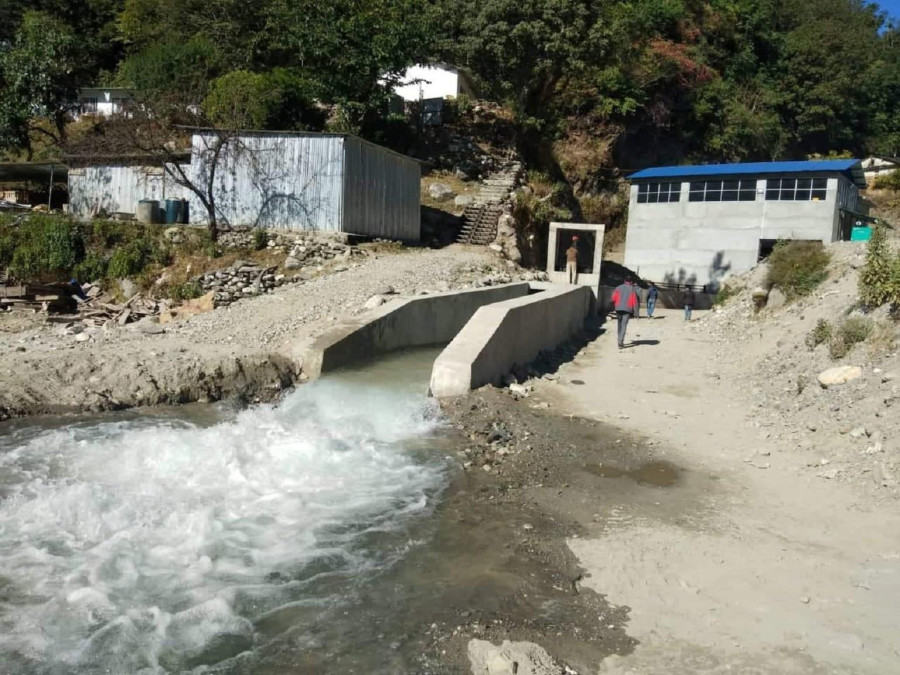Money
Kalanga Gad hydro in Bajhang likely to come online this year
Officials say 70 percent of the construction work at the 85-megawatt plant has been completed.
Basant Pratap Singh
Construction work on the 85-megawatt plant in the far western district began in 2016. Officials expect electricity to start flowing from the scheme into the national grid within a year as 70 percent of the construction work has been completed.
When Kalanga Gad comes online, it will also knock the 45-megawatt Upper Bhotekoshi off the top spot as the largest-privately funded scheme in the country.
According to project chief Bakhat Bahadur Shahi, workers at the site have bored 2 kilometres of the 3-kilometre-long head tunnel, and work at the dam site has concluded.
The project comprises of three schemes located in different water bodies and with a common distribution centre.
“The Sani Gad power plant with an installed capacity of 38 megawatts is also 80 percent complete, and work has been expedited at the construction site of the 10 megawatt Upper Kalanga scheme which is 95 percent complete,” said Shahi.
Although a feasibility study had begun over a decade ago, construction work at the Kalanga Gad project started only last year after it entered into debt financing arrangements with three banks.
The Rs13 billion project is being built with 56 percent debt and 25 percent equity investment from private producers. The project has announced it will distribute 10 percent of the shares to locals.
The Kalanga Gad project had originally planned to start generating electricity by 2020, but the timetable had to be pushed back by a few months owing to multiple setbacks and a major mishap. In November, four construction workers died after falling unconscious inside the main tunnel.
According to project promoter Birendra Malla, workers are digging a 3.8-kilometre tunnel at the Kalanga scheme, an 8.2-kilometre tunnel at Upper Kalanga, and a 2.1-kilometre tunnel at Sani Gad.
With a slew of under-construction power projects, Bajhang has set its sights on generating 621 megawatts of hydroelectricity within a decade.
The Nepal Electricity Authority has also floated plans to develop the 210-megawatt Chainpur-Seti hydroelectric project in Bajhang after completing a feasibility study.
South Korean energy giant Korea Hydro and Nuclear Power recently proposed to build the Chainpur-Seti plant under a public-private partnership model at a cost of $438.65 million.
Chilime Hydropower Company, a subsidiary of the state-owned power utility, is also gearing up to begin construction of the 165-megawatt Seti Khola hydroelectricity project.
Private producer Samridhhi Hydropower Company has initiated the process to acquire a generation licence for the 140-megawatt Upper Seti project located at Saipal rural municipality in Bajhang.
“Bajhang will contribute to electricity generation in a big way after a decade,” said Malla. “Once large scale projects are built, the region will also witness a transformation in terms of electrification and industrialisation.”
As per the records of the Nepal Electricity Authority, only 5.9 percent of the 37,941 households in Bajhang are connected to the national grid.
The remote district has a weak distribution infrastructure. According to private producers, the 33 kV transmission setup and existing substation will not be enough to evacuate all of the power generated in the region as a bunch of power projects are expected to roar into life soon.
“The existing 33 kV transmission line can only carry up to 10 megawatts of electricity,” said Lokjung Kunwar, an official of Omega Energy. “The district will witness spillage of electricity in the absence of a 132 kV transmission line as it will start churning out at least 130 megawatts in less than five years.”




 6.12°C Kathmandu
6.12°C Kathmandu













%20(1).jpg&w=300&height=200)
